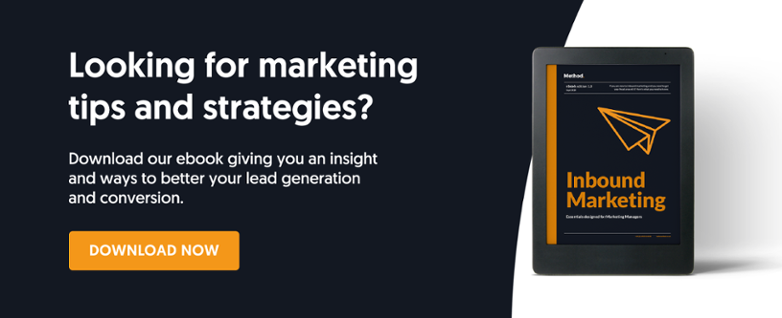Emailing has been a part of our lives for over 40 years now. In 1971, Ray Tomlinson sent the first-ever email in an experiment that studied a computer's ability to exchange information with another computer.
So while it’s certainly not a new concept, we're using emails in a completely different way. Marketing has a predictable way of seeping into every communicative channel possible, and emails are no exception. After the golden success rate of inbound marketing, we’ve learned how to optimise and refine email marketing to produce the best results possible.
Nowadays, we combine marketing and sales together to target buyer personas by directly marketing to them, landing content straight into their mailboxes.
Every business should use email marketing because...
- It allows businesses to establish better company-buyer relationships, and to build on these relationships throughout the customer journey
- Emailing provides a platform for customers to engage
- Allows live-time marketing, diminishing the need to place faith and patience in algorithms (which may or may not make you discoverable)
- The cost is relatively low, meaning the ROI yield is impressive
- It’s a consistent marketing and sales tool that can be used at any point during the buyer’s journey
- It provides the opportunity to individually tailor specific content depending on the customer’s pain points and needs
- Almost everyone is using email, so it’s a guaranteed method of targeting content, no matter who your audience is
There’s no denying that email marketing is extremely effective.
But with the high volume of successful email marketing, it’s scarily easy to get left behind.
If your email marketing isn't engaging enough, it won’t be long before you find yourself dumped in the deep dark depths of the junk folder.
It could be a small, nit-picky thing that you're missing. But sometimes the tiniest mistake can have huge consequences.
Perhaps you’ve been churning out a conveyor belt of marketing and sales emails for quite some time, but your conversions aren’t budging. It’s easy to make common email mistakes.
But luckily, they’re just as easy to avoid as they are to make.
You're not offering anything valuable.
There’s one very common misconception when it comes to email marketing. Lots of businesses prioritise quantity over quality, conjuring up a storm tornado of empty marketing emails and firing them out daily.
Bombarding your audience with these ‘filler’ emails are only going to annoy them, regardless of what stage in the buyer journey they are. Customers don't willingly subscribe to your emails or submit their email addresses if they aren't interested in your products or services in the first place.
Being granted consent to send them emails is already a win. Don’t be aggressively keen and heavily bombard them with tons of emails that don’t offer anything.
How can you avoid this?
Instead of going hard on filler emails, send emails that have actual value. Ensure the content offers something that will genuinely benefit your customer. Think about discounts and special offers, or fill out a reward-based feedback form. Make your call to actions tangible, clear, and easy to take advantage of.
You don’t have a clear system or strategy.
Everything in marketing needs a strategy. It’s a trusty starting point, and it becomes a multi-departmental guide.Without a strategy, things can become quite chaotic. Back-and-forth emails become tightly entangled knots rather than threads. You might end up repeating yourself to the same customer. You might send the wrong content to the wrong addressee. Or even worse, you might totally miss your customer's reply, and end up ignoring them.
These are all red flags that will confuse and frustrate your customer – and unorganised email marketing systems can lead to this very common mishap.
How can you avoid this?
Integrate your email marketing strategy into your business plan. Your overall marketing and sales strategy informs your email schedule. Once you have a strategy and calendar in place, you can follow an email content plan easily.
Outline some concrete goals and map out your content strategy to help you stick to the plan. If you haven’t already, it might be time to update your CRM to ensure customer-company email communication is clearly followed.
You're not tracking your conversions.
Improvement doesn’t happen without first analysing how your email marketing is going in the first place. Without tracking your existing engagement, it's hard to curate a responsive plan.
How can you avoid this?
Start off with tracking your conversions, levels of engagement, and subscriber retention. Note down what works and what doesn’t, and this will help formulate a trusty email plan from there. Sometimes it’s a case of trial and error. Try A/B split testing to see what works, and what doesn’t.
You aren’t checking before you send.
We all know the heart-dropping feeling of accidentally sending an incorrect or incomplete email to an important client. Unless you're super speedy with Gmail, emails can’t be unsent.
Lack of proofreading can lead to these very common mistakes:
- Incorrect addressee
- Spelling and grammar mistakes
- Incorrect information
- Not attaching the right files
Making these mistakes regularly just looks unprofessional.
How can you avoid this?
Add your email address after you’ve created and proofread your content, and always check you’re attaching the correct files. If you're sending content to different customers, make sure their content is correctly tailored to their position within the buyer journey.
Keep your email standards professional and polished, even if you’re being informal. It just looks good.
Your subject line isn’t engaging enough.
Your subject line is like a book title. We’re more likely to pick up books that sound interesting. Emails are the same. Among the shelves of your customer’s email inbox, your email likely sits between a long string of emails that are all fighting to be seen (some of which could be from competitors).
Your subject line is the most important bit of copy because it’s the key to getting discovered. If your subject line is dull, your email will go amiss. This is particularly when emailing your prospects and leads, during the 'attract' stage of inbound marketing.
How can you avoid this?
Ensure your subject lines are polished and well thought out. Choose short copy with a large impact. Maybe add personalisation.
Easily avoided
Little to no engagement? It could be one (or multiple) of these very simple mistakes, that have very simple fixes.
Whatever your system for email marketing, it’s a great way of gaining, retaining, and communicating with your client base. After all, emailing is how you communicate with your customer. It's pretty important, which is why it’s certainly worth checking up on.
So next time you have a marketing review, remember to pay close attention to your email marketing strategy – revamping your sales and marketing emails could just be the thing that sparks a new wave of sales.
Need some help?
If 'buyer persona' and 'inbound marketing' sound like an alien language to you, then feel free to check out our free downloadable resources. Get valuable marketing insights and brush up on your marketing knowledge - and the jargon will make sense in just a couple of clicks.




